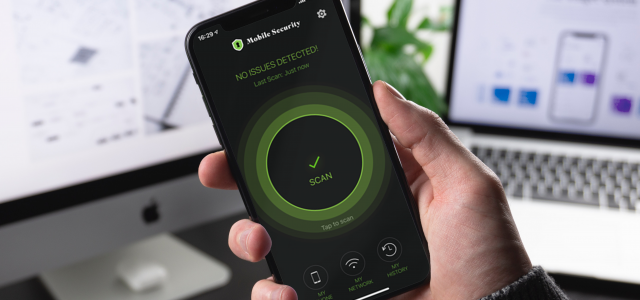RottenSys: Not a Secure Wi-Fi Service At All
March 14, 2018
Malicious Flashlight Apps on Google Play
January 5, 2018
Remote Code Execution Vulnerability on LG Smartphones
May 8, 2018
British Airways Faces 183m Fine Over Passenger Data Breach
ICO says personal data of 500,000
customers was stolen from website
and mobile app
Mobile threats
continue to rise.
919,058 views | Jul 10, 2019, 09:00am
25 Million Android Phones
Infected With Malware That
‘Hides In WhatsApp’
iOS 11 QR Code Vulnerability in Camera APP Could Lead Users
to Malicious Websites
Monday March 26, 2018 6:01 AM PDT
by Mitchel Broussard
iOS SideStepper Vulnerability Undermines MDM Services:
Check Point
Security researchers from check point plan to disclose a flaw at the Black Hat Asia conference which they claim endangers the way mobile device management software interacts with iPhones and iPads.
Almost 150 Million Users
Impacted by New SimBad
Android Adware
SimBad adware found in 210 Android apps available on the official
Google play Store
Spam, phishing, malware: our smartphones are attacked online. You should know the dangers.
Would you use a PC without antivirus software? Anyone who cares about their own security on the net attaches great importance to protection against cyberattacks. But what is self-evident for many on their computer is forgotten on their mobile devices. Because just under half of all smartphone owners use virus protection or a firewall to protect their cell phones from digital attacks. Dangerous viruses and harmful software can nest here as well as on the computer.
What does malware do to my smartphone?
Malware can infect your smartphone. This includes, for example, viruses, Trojans or worms. This allows cybercriminals to take control of your smartphone. In the worst case, a small weak point in your smartphone will completely disrupt your life. Fraudsters can, for example, extort ransoms for your personal data, shop with your account details, call hotlines abroad with your number or write messages to your friends, acquaintances and business partners from your e-mail account.
The right protection for your cell phone is important so that personal things remain really personal. This includes responsible handling of sensitive data, but also a reliable security package for your smartphone.
The 5 most common cyber attacks on smartphones.
USB, WLAN and Bluetooth: Smartphones offer several interfaces through which criminals can transmit malware. If you are not adequately secured, scammers are easy to play and can install various types of malware on your mobile device - mostly without you even knowing about it. We have summarized five of the most common cyber attacks that endanger the security of your smartphone:
1. Phishing
Phishing is fake news from fraudsters who pretend to be lawyers or collection agencies to steal sensitive data or money. In emails or text messages, for example, the recipient is asked to disclose their password. Some fraudsters intimidate those affected directly with high monetary claims. To protect yourself from phishing, you should carefully check the sender of the suspicious message. Spelling mistakes and an impersonal approach also indicate fraud. In general: never send PIN numbers or other personal data! Under no circumstances do reputable companies ask for it in e-mails or SMS.
2. Infected apps
Similar to a computer, malware usually reaches the smartphone unnoticed via harmless applications. Therefore, users often only notice the cyber attack when it is already too late. Especially dangerous Trojans are hidden in apps on your smartphone and, in the worst case, can take complete control of your device. Example: the Android trojan "Dvmap", which was downloaded unnoticed by over 50,000 smartphone owners via a free Android app. In order not to become a victim yourself, you should especially check applications in the Google Play Store before downloading. Other users' comments may contain threats. You should also read the app permissions carefully. If you find it a bit strange, don't download the app.
3. Contaminated files and email attachments
The same applies to a cell phone as to a PC: do not download files whose origin you do not know. With e-mail attachments in particular, you should always check the sender before downloading files. A particularly nasty method: If your acquaintances have been victims of a cyber attack, you may receive messages with contaminated attachments from supposedly familiar contacts. If something seems suspicious to you - for example, if someone suddenly reports a funny photo after years of radio silence - don't click on links or downloads.
4. Infected websites
You can also infect your mobile phone by simply surfing in the browser. When you access a contaminated website, malware is installed on your device in the background. Therefore, do not visit websites that do not seem trustworthy to you. Particular caution applies to shortened links: They are a popular tool, especially in social media posts. Since the exact URL is not visible here, it is even more difficult for users to see which website is really behind the link.
5. Public WiFi networks
Anyone who uses public WLAN networks in cafes or at the airport should not simply use every open network. If you surf here unencrypted, practically anyone who is on the same network can read your data. In addition, criminals have the option to disguise hotspots as official WiFi networks. If you surf unencrypted via such a hotspot, third parties have unhindered access to all data that you transfer during this time. Fraudsters can quickly spy on you, especially when it comes to online banking or other services that use passwords.
Checklist:
How to protect mobile devices from cyber attacks ?
- Install reliable virus protection, for example Salt Mobile Security
- Download updates regularly to close security holes
- Never open attachments from unknown senders
- Check apps before downloading
- Turn off WiFi and Bluetooth when the services are not needed
- Check public WiFi networks before use
- Do not call back unknown numbers
Only 2 steps away from a safe mobile internet experience.
1.
Add the Mobile Security option in your Salt MyAccount
2.
You receive an SMS to download the app from the Google Play Store or Apple App Store





